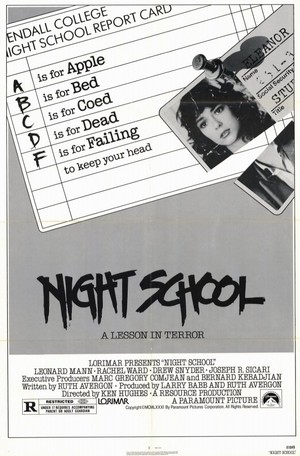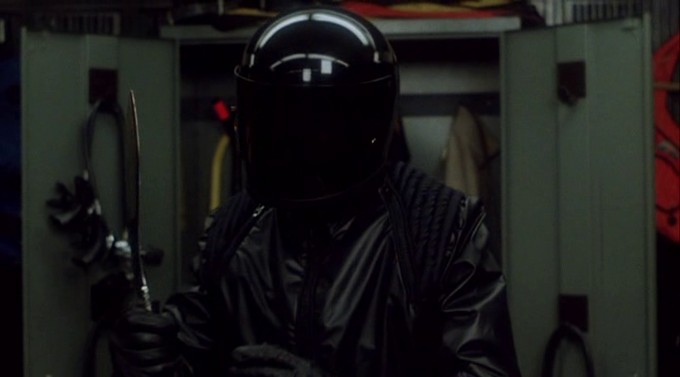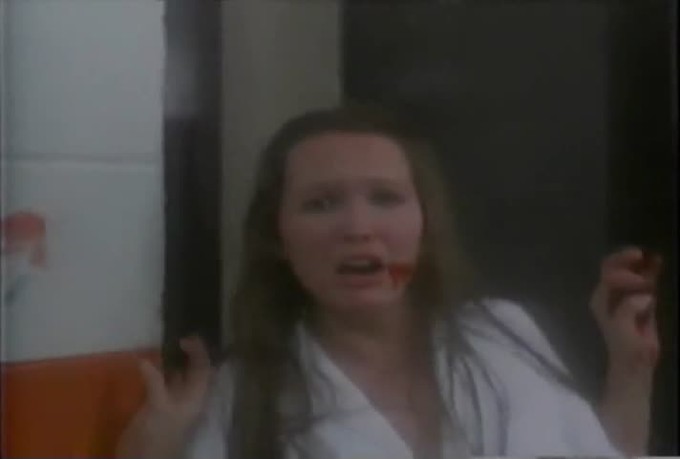We're almost there! Just a few more days and Halloween will finally be upon us, with all of its horrific, frightening joy. I'm sure I'm not the only person out there who has busted into the candy early, so if you also want to get things started a few days ahead of schedule, I might recommend today's slasher offering, 1981's NIGHT SCHOOL. Written by Ruth Avergon and directed by Ken Hughes, the film is a notable entry into slasher horror in the way that it plays with expectations and conventions. Not at all self-aware, but in a way that pulls the audience along and pays off differently than you might anticipate.

NIGHT SCHOOL opens with the brutal murder and decapitation of student and day care center worker Anne Barron (Meb Boden) She has just sent the last child home for the evening and is sitting alone on the playground merry-go-round when she is approached by a figure dressed in black, wearing a motorcycle helmet. The assailant begins spinning the merry-go-round wheel, faster and faster. He pulls out a kukri (it's really not often you see a kukri being used in a horror flick, so points there), keeping it at neck level and taunting Anne every time she passes by, begging him to stop. Finally, he lands the fatal blow, decapitating her and disappearing into the night.
Lieutenant Judd Austin (Leonard Mann) is called to the scene the following morning. Anne's head is found nearby in a bucket of water, her body having been left on the merry-go-round. We learn that this is the second such death in recent weeks, with the first body having been decapitated in a similar fashion. Austin makes note, and begins to investigate to try to connect the two murders.
Austin's investigation takes him to Wendell College, a local girls school were Anne was attending night classes. He meets her friends, talks with the strict Dean Griffin (Annette Miller), and meets Professor Millett (Drew Snyder), an anthropology professor who has a history of maintaining less than professional relationships with his students. As the list of suspects grows to include a local diner owner, his lurking busboy, the killings continue. Wendell College is under attack from a masked lunatic, and Austin has to put the pieces together before the killer can strike again.

The film is brutal and unique in the way it captures the victims' death scenes. NIGHT SCHOOL chooses to get close and personal in its body count. Never does the killer hide in the shadows, only to spring on an unknowing coed who is dead before she even knows what hit her. Here, the killer taunts, pursues, and finally strikes. And though the death scenes aren't particularly bloody, they do make their mark in the way the camera stays with the victim. We focus largely on their faces as they are pursued by the masked killer, sliced at repeatedly, and then finally killed. Though not gory, it is certainly violent, bringing the viewer into a less than comfortable proximity with the victims as they try to evade their inescapable fateThe film is also notable for its female scribe, something of a rarity in horror, particularly in this time period. Ruth Avergon scripted the film when her partner, producer Larry Babb, came up with the idea of a maniac running around Boston, cutting people's heads off. She took that notion and worked with it, bringing the more refined and intriguing story front and center. Though NIGHT SCHOOL doesn't offer any sort of a feminist perspective on horror or on the slasher cycle itself (like say, the work of Rita Mae Brown in SLUMBER PARTY MASSACRE), having a woman writing it does make it stand apart from many of the other films in this time period.

Though, Avergon's approach to the story is also noteworthy as well. The structure of the film is unique in that, although we are introduced to all of the primary characters, we actually spend the majority of our time with Detective Austin as he goes about his investigation. We know enough about the major players that we are able to cut away and follow them through occasionally, and we are, of course, there to observe the scenes when the masked killer tracks down and dispatches each of his victims, but this is where NIGHT SCHOOL deviates from the plot structure of many slasher films. Instead of a close group of friends being picked off one-by-one, only to have the Final Girl take out the killer in the end, the investigator is actually the center of our story. In some instances, the circle of characters is so wide that the victims aren't even aware of one another. In many ways, this makes NIGHT SCHOOL fall in closer with a police procedural than with a slasher film.
But make no mistake - NIGHT SCHOOL is a slasher, through and through. It falls comfortably into this subgenre in the way the events are framed and the way the film is shot. Take away the brutality and the way the camera lingers on the victims during their last moments, and this could easily be just another mystery. The killer isn't at all supernatural, like Jason or Michael, and the story isn't seeking revenge for a past wrong. Once the killer is revealed at the end of the film, the motive was a very pragmatic one, and one that might come into play in any number of thrillers. But the ritualistic nature of the murders themselves and the subjective eye of the camera plant NIGHT SCHOOL very firmly as part of the slasher cycle, and the creative team doesn't shy away from this fact. They revel in the close proximity of the audience to the action, and aren't afraid to play with familiar tropes to help guide audience expectations throughout the film.
NIGHT SCHOOL is a fun entry into the genre in that it includes a lot of the staples that identify it as a slasher film, but it refuses to play by the ordinary rules as well. Many small deviations such as the procedural aspect, the subversion of the standard tropes and the willingness to play with the audience's expectations, make this a memorable film and an entertaining experience.
